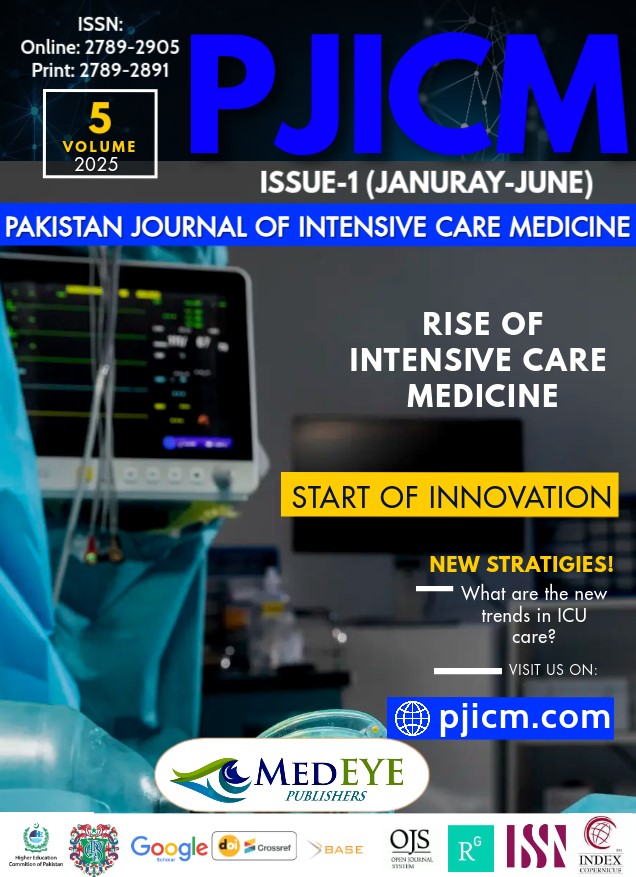FETOMATERNAL OUTCOMES OF ECLAMPSIA AT LIAQUAT MEMORIAL TEACHING HOSPITAL KOHAT
DOI:
https://doi.org/10.54112/pjicm.v5i01.44Keywords:
Eclampsia, Maternal Mortality, Fetal Mortality, Intrauterine Growth Restriction, Preterm Birth, Secondary Care.Abstract
Background: Eclampsia remains a significant cause of maternal and fetal morbidity and mortality, particularly in resource-limited settings. Delays in diagnosis, inadequate antenatal care, and suboptimal management contribute to poor outcomes. Understanding the factors influencing fetomaternal outcomes can help improve management strategies and reduce complications. Objective: To evaluate the fetomaternal outcomes of eclamptic patients managed at Liaquat Memorial Teaching Hospital, Kohat, and identify preventable factors contributing to adverse outcomes. Study Design: Descriptive cross-sectional study. Setting: Liaquat Memorial Teaching Hospital, Kohat. Duration of Study: Six months (08/06/2024—08/12/2024). Methods: A total of 83 eclamptic patients diagnosed between 24 weeks of gestation and 42 days postpartum were included. Data collection involved detailed medical histories, physical examinations, and fetal monitoring. Standard management protocols included magnesium sulfate for seizure control, antihypertensive therapy, and obstetric interventions based on clinical assessment. Maternal outcomes assessed included acute kidney injury (AKI), pulmonary edema, and maternal mortality. Fetal outcomes recorded were intrauterine growth restriction (IUGR), preterm birth, and fetal mortality. Data analysis was performed using SPSS version 25, with descriptive statistics applied to assess frequencies and percentages. Results: The mean maternal age was 31.34 ± 6.643 years, with an average gestational age of 35.95 ± 2.85 weeks. Pre-eclamptic signs were observed in 83.1% of patients. Maternal complications included AKI in 4.8% of cases, pulmonary edema in 6.0%, and a maternal mortality rate of 7.2%. Among fetal outcomes, 47.0% of cases exhibited IUGR, while 49.4% were preterm births. Fetal mortality was recorded at 8.4%, with 91.6% of neonates surviving. Conclusion: Eclampsia remains a critical contributor to maternal and fetal morbidity and mortality. Early diagnosis, effective management, and enhanced antenatal care are essential for improving outcomes. Reducing delays in detection and referral, particularly in resource-constrained settings, is crucial to minimizing complications and enhancing maternal and neonatal survival.
References
Bartal MF, Sibai BM. Eclampsia in the 21st century. American journal of obstetrics and gynecology. 2022;226(2):S1237-53..
Peraçoli JC, Borges VT, Ramos JG, de Carvalho Cavalli R, Costa SH, de Oliveira LG, et al. Pre-eclampsia/eclampsia. Revista Brasileira de Ginecologia e Obstetrícia/RBGO Gynecology and Obstetrics. 2019;41(05):318-32.
Hauspurg A, Jeyabalan A. Postpartum preeclampsia or eclampsia: defining its place and management among the hypertensive disorders of pregnancy. Am J Obstet Gynecol. 2022;226(2S):1211-21.
Gestational Hypertension and Preeclampsia: ACOG Practice Bulletin, Number 222. Obstet Gynecol. 2020;135(6):237-260.
Onoh R, Mamah J, Umeokonkwo C, Onwe E, Ezeonu P, Okafor L. Severe preeclampsia
and eclampsia: a 6-year review at the Federal Teaching Hospital, Abakaliki, Southeast
Nigeria. Trop J Obstet Gynaecol. 2019;36(3):418.
Erez O, Romero R, Jung E, Chaemsaithong P, Bosco M, Suksai M, et al. Preeclampsia and eclampsia: the conceptual evolution of a syndrome. American journal of obstetrics and gynecology. 2022;226(2):786-803.
Ponnaiyan P. Complete Recovery After Antepartum Intracerebral
Hemorrhage In A Case Of Eclampsia. Univ. j. surg. surg. spec. 2017;3(4).
Eddy KE, Vogel JP, Zahroh RI, Bohren MA. Factors affecting use of magnesium sulphate for pre‐eclampsia or eclampsia: a qualitative evidence synthesis. BJOG: An International Journal of Obstetrics & Gynaecology. 2022;129(3):379-91.
Gupta VK. Eclampsia in the 21st Century: Paradigm shift from empirical therapy with magnesium sulfate. Basic science synthesis vs. current WHO-recommended pharmacotherapeutic practice. J. Brain and Neurological Disorders. 2023;6(2):5-9
Laskowska M. Eclampsia: A Critical Pregnancy Complication Demanding Enhanced Maternal Care: A Review. Med Sci Monit. 2023;29:e939919.
Cameron NA, Everitt I, Seegmiller LE, Yee LM, Grobman WA, Khan SS. Trends in the Incidence of New-Onset Hypertensive Disorders of Pregnancy Among Rural and Urban Areas in the United States, 2007 to 2019. J Am Heart Assoc. 2022;11(2):e023791.
Xiao MZX, Whitney D, Guo N, Bentley J, Shaw GM, Druzin ML, et al. Trends in eclampsia in the United States, 2009-2017: a population-based study. J Hypertens. 2022;40(3):490-7.
Raji C, Poovathi M, Nithya D. Prospective study of fetomatemal outcome in eclampsia in a tertiary care hospital. Int J Reprod Contracept Obstet Gynecol. 2016;5(12):4329-35.
Onoh R, Mamah J, Umeokonkwo C, Onwe E, Ezeonu P, Okafor L. Severe preeclampsia and eclampsia: a 6-year review at the Federal Teaching Hospital, Abakaliki, Southeast Nigeria. Trop J Obstet Gynaecol. 2019;36(3):418.
Memon R, Zaki N, Parveen U, Rani K, Mahmood A. Maternal and perinatal outcome in patient with eclampsia attending Isra University Hospital Hyderabad. J Soc Obstet Gynaecol Pak. 2021;11(1):24-27.
Priyanka P, Bharti A. A prospective study of fetomaternal outcomes in patients with eclampsia in a tertiary care hospital in Jharkhand. New Indian J OBGYN. 2024;10(2):372-377.
Dixit P, Mishra TK, Nargawe D, Singh S. Maternal and perinatal outcome in patients with eclampsia: A study done at a tertiary care centre. Cureus. 2023;15(9):e45971.
Jido TA. Eclampsia: maternal and fetal outcome. Afr Health Sci. 2012;12(2):148-152.
Downloads
Published
How to Cite
Issue
Section
License
Copyright (c) 2025 N HUSSAIN , M JABEEN , BS HAMID , J NARGIS , A GUL , S BIBI

This work is licensed under a Creative Commons Attribution-NonCommercial 4.0 International License.












